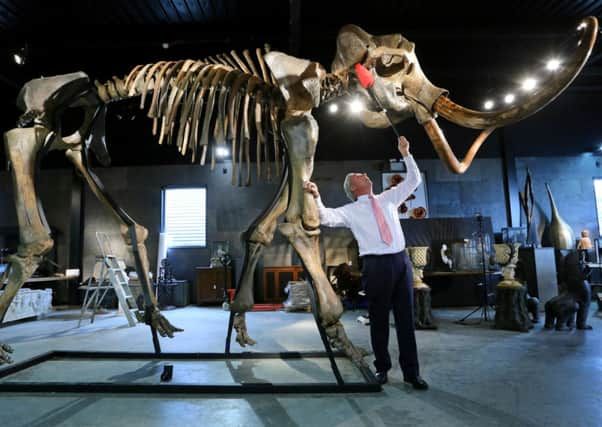Woolly Mammoth skeleton goes up for auction


A private collector is selling the extremely rare Ice Age piece of natural history through Summers Place Auctions.
At 11.6ft tall, the near-complete skeleton, which comes complete with impressive-looking curved tusks, is the highlight of a sale tipped to attract international attention.
CONNECT WITH THE SCOTSMAN
Advertisement
Hide AdAdvertisement
Hide Ad• Subscribe to our daily newsletter (requires registration) and get the latest news, sport and business headlines delivered to your inbox every morning
Experts believe that with its impressive size and weight of up to six tonnes, the extinct mammal would have been male, leading to it being nicknamed Monty.
The creature is believed to be made up of more than 150 bones and during its prime would have been covered in fur to make it well-adapted for the Ice Age conditions.
Errol Fuller, curator of the Second Evolution sale, said it had lain in a disassembled state for decades but has been specially mounted in position for auction.
The mammal’s incredibly heavy skull took four people to lift and fix on to the body, he said. The last of the woolly mammoths died out about 10,000 years ago.
A spokesman for Summers Place said: “Imagine the mammoth covered in fur - long fur on top with a shorter undercoat - and although quite similar to today’s elephant, it had smaller ears and a shorter tail to minimise frostbite and heat loss, so it was well-adapted for the Ice Age.
“Its habitat was the mammoth steppe, stretching across northern Eurasia and North America, so its diet was mainly grass and sedges, which explains why it only had four molar teeth, and also stunning long, curved tusks.
“The woolly mammoth co-existed with early humans, who hunted them for food and used its bones and tusks for making art, which also explains why complete skeletons are so rare.”
Advertisement
Hide AdAdvertisement
Hide AdMonty is not the only extinct animal included in the auction. Another skeleton up for sale is that of a moa, an emu-like bird which used to dominate the New Zealand landscape around 1,000 years ago.
No skeleton of a moa has been offered for sale at a British auction since the 1930s, and it is estimated to sell for between £70,000 and £100,000.
Mr Fuller said: “I am really pleased that this sale includes so many rare and extinct species. We have managed to assemble some of the best examples in this field and it’s a great opportunity to see them all together.”
Last year, a 55ft-long specimen of the long-necked Diplodocus longus dinosaur was bought for the Natural History Museum of Denmark for £400,000 through Summers Place.
The skeleton, believed to be more than 150 million years old, was found almost completely intact in 2009 by the sons of palaeontologist Raimund Albersdoerfer near a quarry in Wyoming in the United States.
SEE ALSO:
SCOTSMAN TABLET AND IPHONE APPS